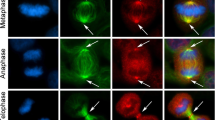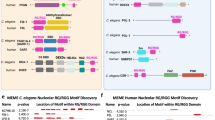Abstract
This paper describes genes from yeast and mouse with significant sequence similarities to aDrosophila gene that encodes the blood cell tumor suppressor pendulin. The protein encoded by the yeast gene, Srp1p, and mouse pendulin share 42% and 51% amino acid identity withDrosophila pendulin, respectively. All three proteins consist of 10.5 degenerate tandem repeats of ∼ 42 amino acids each. Similar repeats occur in a superfamily of proteins that includes theDrosophila Armadillo protein. All three proteins contain a consensus sequence for a bipartite nuclear localization signal (NLS) in the N-terminal domain, which is not part of the repeat structure. Confocal microscopic analysis of yeast cells stained with antibodies against Srp1p reveals that this protein is intranuclear throughout the cell cycle. Targeted gene disruption shows thatSRP1 is an essential gene. Despite their sequence similarities,Drosophila and mouse pendulin are unable to rescue the lethality of anSRP1 disruption. We demonstrate that yeast cells depleted of Srp1p arrest in mitosis with a G2 content of DNA. Arrested cells display abnormal structures and orientations of the mitotic spindles, aberrant segregation of the chromatin and the nuclei, and threads of chromatin emanating from the bulk of nuclear DNA. This phenotype suggests that Srplp is required for the normal function of microtubules and the spindle pole bodies, as well as for nuclear integrity. We suggest that Srp1p interacts with multiple components of the cell nucleus that are required for mitosis and discuss its functional similarities to, and differences fromDrosophila pendulin.
Similar content being viewed by others
References
Adams AEM, Pringle J (1984) Relationship of actin and tubulin distribution to bud growth in wildtype and morphogenetic mutantSaccharomyces cerevisiae. J Cell Biol 98: 934–945
Belanger KD, Kenna MA, Wei S, Davis LI (1994) Genetic and physical interactions between Srplp and nuclear pore complex proteins Nup1p and Nup2p. J Cell Biol 126:619–630
Berlin V, Styles CA, Fink GR (1990)BIK1, a protein required for microtubule function during mating and mitosis inSaccharomyces cerevisiae, colocalizes with tubulin. J Cell Biol 111:2573–2586
Brown MT, Goetsch L, Hartwell LH (1993)MIF2 is required for mitotic spindle integrity during anaphase spindle elongation in Saccharomyces cerevisiae. J Cell Biol 123: 387–403
Cortes P, Ye Z-S, Baltimore D (1994) RAG-1 interacts with the repeated amino acid motif of the human homologue of the yeast protein SRPI. Proc Natl Acad Sci USA 91:7633–7637
Cuomo CA, Kirch SA, Gyuris J, Brent R, Oettinger MA (1994) Rch1, a protein that specifically interacts with the RAG-1 recombination-activating protein. Proc Natl Acad Sci USA 91:6156–6160
Errede B, Levin DE (1993) A conserved kinase cascade for MAP kinase activation in yeast. Curt Opin Cell Biol 5:254–260
Eshel D, Urrestarazu LA, Vissers S, Jauniaux J-C, van Vliet-Reedijk JC, Planta RJ, Gibbons IR (1993) Cytoplasmic dynein is required for normal nuclear segregation in yeast. Proc Natl Acad Sci USA 90:11172–11176
Fantino E, Marguet D, Lauquin GJ-M (1992) Downstream activating sequence within the coding region of a yeast gene: specific binding in vitro of RAP1 protein. Mol Gen Genet 236:65–75
Gerst JE, Ferguson K, Vojtek A, Wigler M, Field J (1991) CAP is a bifunctional component of the Saccharomyces cerevisiae adenylyl cyclase complex. Mol Cell Biol 11:1248–1257
Gibson SI, Surosky RT, Tye B (1990) The phenotype of the minichromosome maintenance mutantmcm3 is characteristic of mutants defective in DNA replication. Mol Cell Biol 10: 5707–5720
Görlich D, Prehn S, Laskey R, Hartmann E (1994) Isolation of a protein that is essential for the first step of nuclear protein import. Cell 79:767–778
Guthrie C, Fink GR (1991) Guide to yeast genetics and molecular biology. Methods Enzymol 194
Hartwell LH (1967) Macromolecular synthesis in temperature sensitive mutants of yeast. J Bacteriol 93: 1662–1670
Höög C (1991) Isolation of a large number of novel mammalian genes by a differential cDNA library screening strategy. Nucleic Acids Res 19:6123–6127
Hoyt MA, He L, Loo KK, Saunders WS (1992) TwoSaccharomyces cerevisiae kinesin-related gene products required for mitotic spindle assembly. J Cell Biol 118:109–120.
Hughes DA, Ashworth A, Marshall CJ (1993) Complementation ofbyr1 in fission yeast by mammalian MAP kinase kinase requires coexpression of Raf kinase. Nature 364: 349–342
Jans DA, Ackermann MJ, Bishoff JR, Beach DH, Peters R (1991) p34cdc2-mediated phosphorylation at T124 inhibits nuclear import of SV-40 T antigen proteins. J Cell Biol 115: 1203–1212
Jimenez J, Alphey L, Nurse P, Glover DM (1990) Complementation of fission yeastcdc2ts andcdc25ts mutants identifies two cell cycle genes from Drosophila: acdc2 homologue and string. EMBO J 9:3565–3571
Johnson GL, Vaillancourt RR (1994) Sequential protein kinase reactions controlling cell growth and differentiation. Curt Opin Cell Biol 6:230–238
Johnston GC, Pringle JR, Hartwell LH (1977) Coordination of growth with cell division in the yeastSaccharomyces cerevisiae. Exp Cell Res 105:79–98
Kilmartin J, Adams AEM (1994) Structural rearrangements of tubulin and actin during the cell cycle of the yeastSaccharomyces. J Cell Biol 98:922–933
Kirschner MW (1992) The cell cycle then and now. Trends Biochem Sci 17:281–285
Kurjan J (1993) The pheromone response pathway inSaccharomyces cerevisiae. Annu Rev Genet 27:147–179
Küssel P (1991) Pendulin im Zellzyklus. Diploma thesis, Universität Tübingen
Küssel P, Frasch M (1995) Pendulin, aDrosophila protein with cell cycle-dependent nuclear localization, acts in cell proliferation control. J Cell Biol 129:1491–1507
Lehner CF, O'Farrell P (1990)Drosophila cdc2 homologs: a functional homolog is coexpressed with a cognate variant. EMBO J 9:3573–3581
Leopold P, O'Farrell PH (1991) An evolutionarily conserved cyclin homolog fromDrosophila rescues yeast deficient in G1 cyclins. Cell 66:1207–1216
Li Y-Y, Yeh E, Hays T, Bloom K (1993) Disruption of mitotic spindle orientation in a yeast dynein mutant. Proc Natl Acad Sci USA 90:10096–10100
Maniatis T, Fritsch ER, Sambrook J (1982) Molecular cloning: a laboratory manual. Cold Spring Harbor Laboratory Press, Cold Spring Harbor, New York
Marguet D, Guo XJ, Lauquin GJ-M (1988) Yeast geneSRP1 (serine-rich protein). Intragenic repeat structure and identification of a family ofSRP1-related DNA sequences. J Mol Biol 202:455–470
McGrew JT, Goetsch L, Byers B, Baum P (1992) Requirement forESP1 in the nuclear division ofSaccharomyces cerevisiae. Mol Biol Cell 3:1443–1454
Meluh PB, Rose MD (1990)KAR3, a kinesin-related gene required for yeast nuclear fusion. Cell 60:1029–1041
Moll T, Tebb G, Surana U, Robitsch H, Nasmyth K (1991) The role of phosphorylation and the CDC28 protein kinase in cell cycleregulated nuclear import of theS. cerevisiae transcription factor SWI5. Cell 66:743–758
Nehrbass U, Kern H, Mutvei A, Horstmann H, Marshallsay M, Hurt EC (1990) NSP1: a yeast nuclear envelope protein localized at the nuclear pores exerts its essential function by carboxyterminal domain. Cell 61:979–989
Neiman AM, Stevenson BJ, Xu H-P, Sprague Jr. GF, Herskowitz I, Wigler M, Marcus S (1993) Functional homology of protein kinases required for sexual differentiation inSchizosaccharomyces pombe andSaccharomyces cerevisiae suggests a conserved signal transduction module in eukaryotic organisms. Mol Biol Cell 4:107–120
Nurse P (1990) Universal control mechanism regulating onset of M-phase. Nature 344:503–508
O'Neill KD, DeGrado WF (1990) How calmodulin binds its targets: sequence independent recognition of amphiphilic helices. Trends Biochem Sci 15:59–64
Ohtsubo M, Yoshida T, Seino H, Nishitani H, Clark KL, Sprague GF Jr, Frasch M, Nishimoto T (1991) Mutation of the hamster cell cycle geneRCC1 is complemented by the homologous genes ofDrosophila andS. cerevisiae. EMBO J 10:1265–1273
Palmer RE, Sullivan DS, Huffaker T, Koshland D (1992) Role of astral microtubules and actin in spindle orientation and migration in the budding yeastSaccharomyces cerevisiae. J Cell Biol 119:583–593
Perrimon N (1994) Signalling pathways initiated by receptor protein tyrosine kinases inDrosophila. Curr Opin Cell Biol 6:260–266
Rasmussen CD, Means AR (1989) Calmodulin, cell growth and gene expression. Trends Neurosci 12:433–438
Robbins J, Dilworth SM, Laskey R, Dingwall C (1991) Two interdependent basic domains in nucleoplasmin nuclear targeting sequence: identification of a class of bipartite nuclear targeting sequence. Cell 64: 615–623
Roof DM, Meluh PB, Rose MD (1992) Kinesin-related proteins required for assembly of the mitotic spindle. J Cell Biol 118: 95–108
Rose MD, Fink GR (1987)KAR1, a gene required for function of both intranuclear and extranuclear microtubules in yeast. Cell 48:1047–1060
Saunders WS, Hoyt MA (1992) Kinesin-related proteins required for structural integrity of the mitotic spindle. Cell 70:451–458
Sherman F, Fink GR, Hicks JB (1986) Laboratory course manual for methods in yeast genetics. Cold Spring Harbor Laboratory Press, Cold Spring Harbor, New York
Sullivan DS, Huffaker TC (1992) Astral microtubules are not required for anaphase B inSaccharomyces cerevisiae. J Cell Biol 119:397–388
Yano R, Oakes M, Yamaghishi M, Dodd JA, Nomura M (1992) Cloning and characterization ofSRP1, a suppressor of temperature-sensitive RNA polymerase I mutations, inSaccharomyces cerevisiae. Mol Cell Biol 12:5640–5651
Author information
Authors and Affiliations
Additional information
Communicated by G. P. Hollenberg
Rights and permissions
About this article
Cite this article
Küssel, P., Frasch, M. Yeast Srp1, a nuclear protein related toDrosophila and mouse pendulin, is required for normal migration, division, and integrity of nuclei during mitosis. Molec. Gen. Genet. 248, 351–363 (1995). https://doi.org/10.1007/BF02191602
Received:
Accepted:
Issue Date:
DOI: https://doi.org/10.1007/BF02191602




